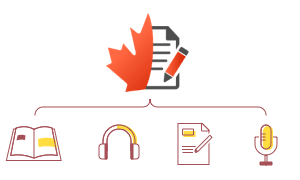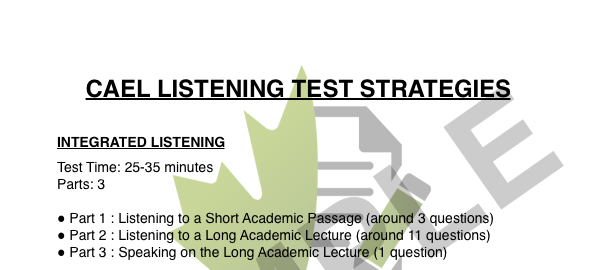CAEL Free Practice Test
Get a CAEL sample test PDF, a CAEL test writing sample, CAEL writing topics, and more!
604-207-5520
How Grading Works
CAEL scores are reported on a scale from 10 - 90 with specific criteria of what performance represents. These scores can be converted to IELTS, which can be converted to CLB (Canadian Language Benchmark). CAEL scores are rounded to the nearest 10.

Grading Criteria
Reading
Reads academic texts with ease demonstrating comprehension equal to that of experienced academic readers.
Writing
Writes with authority and style demonstrating mastery of appropriate, concise and persuasive academic writing.
Listening
Comprehends lectures as well as an experienced academic listener.
Speaking
Speaks with authority on a variety of topics. Demonstrates flexibility, controls nuance and speaks with spontaneity and comprehensibility.
Reading
Reads and comprehends academic texts with ease. Can interpret information with flexibility.
Writing
Readily responds to the demands of the topic and presents information clearly and logically.
Listening
Understands lectures with apparent ease.
Speaking
Speaks with ease presenting information clearly and logically.
Reading
Understands main ideas is able to identify most relevant details. Can interpret information with some flexibility.
Writing
Can develop a thesis using a range of support and uses language that is generally accurate.
Listening
Understand information regarding both main ideas and supporting details. May lack some flexibility and miss some information.
Speaking
Speaks fluently, flexibly and with a degree of ease. Compensates strategically for limitations but communicates most required information clearly.
Reading
Understands main ideas but may misinterpret information. Can identify some relevant details but reads slowly and with greater effort than most academic readers.
Writing
Addresses the topic to a degree but with limited clarity and cohesiveness.
Listening
Processes most of the lecture for general ideas but may miss or misinterpret details. Overall understanding is still somewhat restricted.
Speaking
Speaks with some fluency and flexibility but speaks unevenly; at times there is a natural easy quality to the response but at other times the response breaks down.
Reading
Understands main ideas but is restricted by limited vocabulary and a lack of familiarity with textual conventions.
Writing
Makes links among ideas and addresses the topic but writing lacks clarity and cohesiveness.
Listening
Identifies the meaning of some unfamiliar terms but overall understanding is restricted and uneven.
Speaking
Can speak with some fluency but without flexibility and with noticeable effort.
Reading
Understands some of the main ideas but is unable to identify specific, relevant ideas; reads with limited accuracy and fluency.
Writing
Writes something related to the topic but writing is not predictable and language is restricted.
Listening
Makes some sense sections of lectures by guessing but overall understanding is limited.
Speaking
Can speak but with false starts, hesitations and some mispronounced words. Provides studied and careful responses.
Reading
Understands the main idea at times but misses almost all supporting detail.
Writing
Uses words randomly but language is very restricted and/or ungrammatical.
Listening
Takes some meaning from individual words but overall understanding is sketchy and random.
Speaking
Communicates some information but mispronounces many words and speaks with great difficulty and many long pauses.
CAEL Sections
Speaking
The first two tasks will focus on various aspects of test takers’ educational plans or experiences, or other topics related to academic study. In the third task, there will be an information graphic, and test takers will describe and draw conclusions about it.

- Parts
- 3
- Questions
- 3
- Time
- 7 - 10 mins.
- Question Type
- Spoken
Integrated Reading
The reading passages come in two types: short and long. The short passage covers a typical situation you might find in a post-secondary situation, like a lab orientation, guidelines for a report, or rulese for a presentation. The longer passages are academic texts about specific topics.

- Parts
- 2
- Questions
- 15 - 25
- Time
- 35 - 50 mins.
- Question Type
- Spoken and Multiple Choice
Integrated Listening
The listening components come in two parts: short and long. The short listening passage covers a typical situation you might find in a post-secondary situation, like a course syllabus or guidelines for a project. This passage is usually only a few minutes in length. The longer passages are academic lectures about specific topics and may be up to 5 minutes. The questions are generally sequential, and you will only hear the audio only once.

- Parts
- 2
- Questions
- 15 - 25
- Time
- 25 - 35 mins.
- Question Type
- Spoken and Multiple Choice
Academic Unit A
There are three sections, each of which discusses some aspect of the same topic. The topic can range from science or art - for example, it might discuss the solar system or psychology. First, you will read a passage, and then listen to a passage, each followed by a series of comprehension questions. After that, you will write a response to a question that incorporates information from both passages. Your response must be a minimum of 250 words.

- Parts
- 3
- Questions
- 23 - 30
- Time
- 60 - 70 mins.
- Question Type
- Written
Academic Unit B
There are three sections, similar to Academic Unit A, each of which focused on some aspect of the same topic. You will have a reading passage, then a listening passaage, each followed with comprehension questions. After that, you will write a short response to a question, using information from both reading and writing sections. Your response must be a minimum of 100 words.

- Parts
- 3
- Questions
- 23 - 30
- Time
- 45 - 45 mins.
- Question Type
- Written
CAEL vs IELTS
- CAEL is a practical test, which is more related to real life.
- Each part of the exam focuses only one topic. The test site is small and easy to prepare.
- Other portions of the exam can be used as reference and often corroborate with each other.
- The questions are very straightforward, with less synonymous conversion of keyword positioning words and fewer traps, making it easier for students to find accurate answers and get high scores. The test format is derived from Canadian classrooms and is very suitable for local international students.
- Candidates for the CAEL test can take the computer-based test at home or at the test center. This flexibility is meant to accommodate for test takers with different circumstances.
- IELTS is based on theory and emphasizes ability and high scores. The examination is gradually "de-skilled.”
- IELTS requires a wide range of knowledge because each section contains different topics. The reading score standard is higher, which requires long-term accumulation, and is difficult to quickly improve.
- Vocabulary and question types are diverse, and IELTS writing standards are also high, requiring long-term training and skills.
- Keyword positioning words are frequently synonymous, and there are many "traps" in the questions.
- The test must be written in a designated center. Space is limited, registration is competitive, and the test cycle is long.
More Test Resources for You

We provide professional in-house practice materials for our students, as well as provide workshops with our close partners for students to get additional help. We ensure you are completely prepared with a variety of resources, only available for our students.
Frequently Asked Questions about CAEL Grading
You can apply for a re-evaluation of some or all your components of your exam, so long it is made within 6 months of the test date. You must pay a fee of $65 and if the score changes based on the section that you requested, the fee will be refunded. There is a limit to one re-evaluation for any particular component of the test.
If you would like to retake the exam, you may register for no more than one test session within 4 calendar days. It is recommended that you take the time to study materials before doing so.
If you’re taking the exam remotely, you can launch your exam up to 30 minutes before the test time. You will go through self check-in by ttaking a photo of yourself and the ID you registered with. You will follow a checklist to ensure your system is ready, and then you’ll meet with your readiness agent. You will have to show them a 360-degree view of your room and may be requested to remove unnecessary items. Afterwards, the exam will begin.
If taking the exam at a testing centre, you must arrive 45 minutes beforehand. Your photo will be taken and you will be shown to your workstation. You cannot bring valuables with you, so leave those in your car or don’t bring them with you.
If you require technical support any time during the exam, you can contact your proctor through ProProctor. If you need to talk to them at any point, raise your hand or use the ProProtector Chat to notify them.
CAEL scores are reported on a scale from 10 - 90 with accompanying descriptors of what performance represents. The overall score is calculated as an equally weighted average of the four component scores rounded to the neareest ten-point interval. CAEL scores can be converted to match IELTS score for easy comparisons.
CAEL scores will be available to you and other institutions for 2 years from the date of the test. The length of time that your scores are valid for various institutions, however, is determined by their individual policies, so be sure to communicate with your institution about this.
If you require special accommodations, you will need to submit a request prior to the testing date. You can access the necessary forms through your CAEL account.
Our prices are fixed; however, there are occasional promotions, so please stay in touch with us to learn more about these sales! We also give preferential prices to students who recommend new students, so please spread the word about our services to your friends who may need them!





